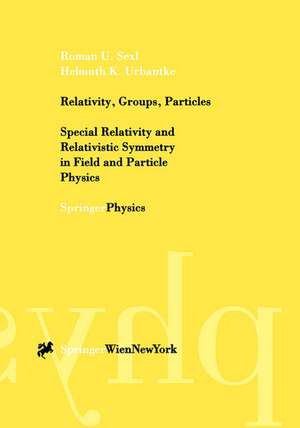Relativity, Groups, Particles: Special Relativity and Relativistic Symmetry in Field and Particle Physics
Autor Roman U. Sexl Traducere de H.K. Urbantke Autor Helmuth K. Urbantkeen Limba Engleză Paperback – 3 oct 2000
Preț: 511.70 lei
Preț vechi: 602.00 lei
-15% Nou
Puncte Express: 768
Preț estimativ în valută:
97.92€ • 102.49$ • 81.50£
97.92€ • 102.49$ • 81.50£
Carte tipărită la comandă
Livrare economică 31 martie-14 aprilie
Preluare comenzi: 021 569.72.76
Specificații
ISBN-13: 9783211834435
ISBN-10: 3211834435
Pagini: 400
Ilustrații: XII, 388 p.
Dimensiuni: 178 x 254 x 21 mm
Greutate: 0.76 kg
Ediția:Softcover reprint of the original 1st ed. 2001
Editura: SPRINGER VIENNA
Colecția Springer
Locul publicării:Vienna, Austria
ISBN-10: 3211834435
Pagini: 400
Ilustrații: XII, 388 p.
Dimensiuni: 178 x 254 x 21 mm
Greutate: 0.76 kg
Ediția:Softcover reprint of the original 1st ed. 2001
Editura: SPRINGER VIENNA
Colecția Springer
Locul publicării:Vienna, Austria
Public țintă
ResearchCuprins
1 The Lorentz Transformation.- 1.1 Inertial Systems.- 1.2 The Principle of Relativity.- 1.3 Consequences from the Principle of Relativity.- Appendix 1: Reciprocity of Velocities.- Appendix 2: Some Orthogonal Concomitants of Vectors.- 1.4 Invariance of the Speed of Light. Lorentz Transformation.- 1.5 The Line Element.- 1.6 Michelson, Lorentz, Poincare, Einstein.- 2 Physical Interpretation.- 2.1 Geometric Representation of Lorentz Transformations.- 2.2 Relativity of Simultaneity. Causality.- 2.3 Faster than Light.- 2.4 Lorentz Contraction.- 2.5 Retardation Effects: Invisibility of Length Contraction and Apparent Superluminal Speeds.- 2.6 Proper Time and Time Dilation.- 2.7 The Clock or Twin Paradox.- 2.8 On the Influence of Acceleration upon Clocks.- 2.9 Addition of Velocities.- 2.10 Thomas Precession.- 2.11 On Clock Synchronization.- 3 Lorentz Group, Poincare Group, and Minkowski Geometry.- 3.1 Lorentz Group and Poincare Group.- 3.2 Minkowski Space. Four-Vectors.- 3.3 Passive and ActiveTransformations. Reversals.- 3.4 Contravariant and Covariant Components. Fields.- 4 Relativistic Mechanics.- 4.1 Kinematics.- Appendix: Geometry of Relativistic Velocity Space.- 4.2 Collision Laws. Relativistic Mass Increase.- 4.3 Photons: Doppler Effect and Compton Effect.- 4.4 Conversion of Mass into Energy. Mass Defect.- 4.5 Relativistic Phase Space.- Appendix: Invariance of Rn(q).- 5 Relativistic Electrodynamics.- 5.1 Forces.- 5.2 Covariant Maxwell Equations.- 5.3 Lorentz Force.- 5.4 Tensor Algebra.- 5.5 Invariant Tensors, Metric Tensor.- 5.6 Tensor Fields and Tensor Analysis.- 5.7 The Full System of Maxwell Equations. Charge Conservation.- 5.8 Discussion of the Transformation Properties.- 5.9 Conservation Laws. Stress-Energy-Momentum Tensor.- 5.10 Charged Particles.- 6 The Lorentz Group and Some of Its Representations.- 6.1 The Lorentz Group as a Lie Group.- 6.2 The Lorentz Group as a Quasidirect Product.- 6.3 Some Subgroups of the Lorentz Group.- Appendix 1: Active Lorentz Transformations.- Appendix 2: Simplicity of the Lorentz Group L++.- 6.4 Some Representations of the Lorentz Group.- 6.5 Direct Sums and Irreducible Representations.- 6.6 Schur’s Lemma.- 7 Representation Theory of the Rotation Group.- 7.1 The Rotation Group SO(3,R).- 7.2 Infinitesimal Transformations.- 7.3 Lie Algebra and Representations of SO(3).- 7.4 Lie Algebras of Lie Groups.- 7.5 Unitary Irreducible Representations of SO(3).- 7.6 SU(2), Spinors, and Representation of Finite Rotations.- 7.7 Representations on Function Spaces.- 7.8 Description of Particles with Spin.- 7.9 The Full Orthogonal Group 0(3).- 7.10 On Multivalued and Ray Representations.- 8 Representation Theory of the Lorentz Group.- 8.1 Lie Algebra and Representations of L++.- 8.2 The Spinor Representation.- 8.3 Spinor Algebra.- Appendix: Determination of the Lower Clebsch-Gordan Terms.- 8.4 The Relation between Spinors and Tensors.- Appendix 1: Spinors and Lightlike 4-Vectors.- Appendix 2: Intrinsic Classification of LorentzTransformations.- 8.5 Representations of the Full Lorentz Group.- 9 Representation Theory of the Poincaré Group.- 9.1 Fields and Field Equations. Dirac Equation.- Appendix: Dirac Spinors and Clifford-Dirac Algebra.- 9.2 Relativistic Covariance in Quantum Mechanics.- 9.3 Lie Algebra and Invariants of the Poincare Group.- 9.4 Irreducible Unitary Representations of the Poincare Group.- 9.5 Representation Theory of P++ and Local Field Equations.- 9.6 Irreducible Semiunitary Ray Representations of P.- 10 Conservation Laws in Relativistic Field Theory.- 10.1 Action Principle and Noether’s Theorem.- 10.2 Application to Poincaré-Covariant Field Theory.- 10.3 Relativistic Hydrodynamics.- Appendices.- A Basic Concepts from Group Theory.- A.1 Definition of Groups.- A.2 Subgroups and Factor Groups.- A.3 Homomorphisms, Extensions, Products.- A.4 Transformation Groups.- B Abstract Multilinear Algebra.- B.1 Semilinear Maps.- B.2 Dual Space.- B.3 Complex-Conjugate Space.- B.4 Transposition, Complex,and Hermitian Conjugation.- B.5 Bi- and Sesquilinear Forms.- B.6 Real and Complex Structures.- B.7 Direct Sums.- B.8 Tensor Products.- B.9 Complexification.- B.10 The Tensor Algebra over a Vector Space.- B.11 Symmetric and Exterior Algebra.- B.12 Inner Product. Creation and Annihilation Operators.- B.13 Duality in Exterior Algebra.- C Majorana Spinors, Charge Conjugation, and Time Reversal in Dirac Theory.- C.1 Dirac Algebra Reconsidered.- C.2 Majorana Spinors, Charge Conjugation, Time Reversal.- D Poincaré Covariance in Second Quantization.- D.l The One-Particle Space.- D.2 Fock Space and Field Operator.- D.3 Poincaré Covariance and Conserved Quantities.- Notation.- Author Index.
Recenzii
"... I wish that many readers from the large English-speaking area ... will step on it and profit from an illuminating textbook which was reserved to German-language readers up to now." Wolfgang Hasse - General Relativity and Gravitation, vol. 34, 12/2002
Caracteristici
Successful mix between introduction to relativity theory and its applications in high energy physics Fine balance between formal structure and physical discussion Successful textbook in the German language Includes supplementary material: sn.pub/extras



